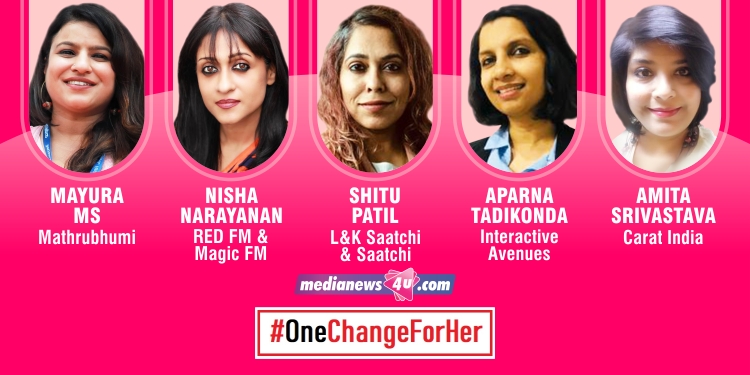Change the way the world perceives her strength

As a leader, I believe the path to equality is equivalent to the path to diversity. It remains long and ever-shifting but it has also never been graver and more pressing. Women are already strong, it is about time we change the way the world perceives their strength.
A healthy and diverse workplace creates safe spaces for women. For present times, it might be monumental but let’s not overlook how it is also a basic necessity. Recognition matters, and twin opportunities matter. If this means addressing the ominous gender pay gap, and questioning diversity & inclusion, as leaders we have to put on this hat.
This International Women’s Day, let us continue to preach and lead our communities and women toward a world where gender does not define you anymore. Let’s be more accommodating and more human.
– Nisha Narayanan, Director & COO, RED FM & Magic FM
The narrative must change

We are constantly in pursuit of goals. But goals like identity are never static. It is a process in motion. Every women’s day reminds us of this fundamental truth. For example, why should we always be told that we are women professionals? Madhavikutty is still referred to as a woman writer. Historians CONTINUE TO call Indira Gandhi a woman leader even now. We never do this to OV Vijayan or Nehru. Isn’t it time we moved on? The narrative must change. The conversation around gender-neutral terminology has to take place against the backdrop of the global rise of women across the spectrum.
Gender-neutral words like actor, writer, player, leader mean a lot in the present. They reflect the progress we have achieved. As the American thinker Susan Zontag put it: ”If I am going to play chess, I don’t think I should play it differently because I am a woman. The fight is not just for equality, but for equal power as well.’
– Mayura MS, Director – Digital Business, Mathrubhumi
Review, question and analyse personal unconscious bias

Unconscious biases are associations and feelings of bias hidden under the surface. They need to be addressed by the leaders of today as they don’t necessarily align with the declared beliefs.
The society and often workplaces tend to stereotype women as the lead caregiver at home and men as lead bread earners. So, the bias runs deep in our subconscious. For example, when a woman leaves early from work it is assumed that she is going to tend to her domestic requirements. What if she wants to conserve her time and energy, beat the traffic, and later continue her work from home? If the man was to leave early from work, it would often be assumed he is leaving for a meeting.
When a woman quits, she might be asked if she wants to concentrate on her domestic life, but a man would never be asked that.
The world today is fast changing, I believe there is an urgent need to bring about a change in our mindsets too.
Leaders can address this by helping employees understand how individuals are impacted by unconscious bias, and what actions reinforce bias. A way to build awareness and address unconscious bias is to encourage employees to review, question and analyse their personal unconscious bias.
– Shitu Patil, National Head of Art & ECD, L&K Saatchi & Saatchi
No two genders are equal physically, emotionally, or mentally

There’s a growing awareness for inclusivity and diversity in the workplace, yet many organisations fail to put their plans into action. In the media and advertising industry, increased representation of women is a step in the right direction, but true inclusivity means creating a workplace culture that values and supports the diverse experiences, perspectives, and contributions of women. This requires acknowledging and addressing systemic biases and barriers that have historically been the industry norm. Truly inclusive workplaces actively work to ensure women are represented at all levels, from the entry-level to the boardroom, by implementing policies that promote gender diversity and equity, and flexible work arrangements. Success at the workplace should not be based on established norms for all genders, and trade-offs shouldn’t be made based on the life stage of a woman. Equality means acknowledging that no two genders are equal physically, emotionally, or mentally, but they should have equal opportunities to grow and succeed. Understanding the natural progression of each gender and fostering a truly inclusive environment are direct ways to address this.
– Aparna Tadikonda, EVP – South, Interactive Avenues (A Reprise Network Company and the digital arm of Mediabrands India)
Remove systemic barriers

There are a number of reasons why even today, very few women reach leadership positions, in most industries. While a lot of progress has been made over the years, much still needs to be done. Women are often subject to gender biases and stereotypes including assumptions that women are less competent or ambitious than men. They are often underrepresented in leadership positions, which can make it difficult for them to find mentors or sponsors who can help them navigate the path to leadership. Certain factors – like unequal pay, lack of access to training and development programs, and biases in hiring and promotion decisions – can also lead to fewer opportunities to develop the skills and experience required for leadership positions. Many women face competing demands on their time, which can make it difficult to take on leadership roles that require long hours or extensive travel. Sometimes, systemic barriers such as company policies or cultural norms make it more difficult for women to advance.
Most of these factors are interrelated and can reinforce each other which perpetuates a cycle of inequality that is difficult to break through. Addressing these challenges will require a multifaceted approach that includes changes not only in workplace culture, policies, and practices, but also broader societal changes that challenge gender stereotypes and biases.
One of the most important ways to manage this at the workplace is to create a culture of inclusion and equity. Organisations must address gender bias by educating employees about practices and policies designed to promote gender equity. There should be a formal mentorship and sponsorship programme that pairs potential women leaders with other experienced leaders who can guide them in their career paths. Women should have access to the same opportunities for growth and development as men, including training and development programmes, leadership programmes, and opportunities for promotion. Women still earn less than men on average, so ensuring that women are paid equally for their work is essential. Companies can conduct regular pay equity audits to identify and address any pay disparities. Offering flexible work arrangements, such as telecommuting or flexible hours, can make it easier for women to balance their work and personal responsibilities.
Overall, creating a workplace culture that is supportive of women and promotes gender equity is essential for empowering women in the workplace. This requires a commitment from all levels of the organisation, including leadership, management, and employees.
There are several key stakeholders in an organisation that can play a crucial role in ensuring the success of women leaders. These include senior leaders who are the driving force behind an organisation’s culture and policies. HR has a very big role to play in designing the policies and practices to support diversity and inclusion. Managers and supervisors can provide coaching, mentorship, and feedback to help women grow and advance. Peers – men, as well as women – play a very large role in offering a supportive and growth-oriented community to share knowledge and experiences and promote a culture of inclusion and equity.
By working together, these stakeholders can co-create a more supportive and inclusive environment for women leaders, helping them to thrive and contribute to the organisation’s success.
– Amita Srivastava, Vice President – West, Carat India

















